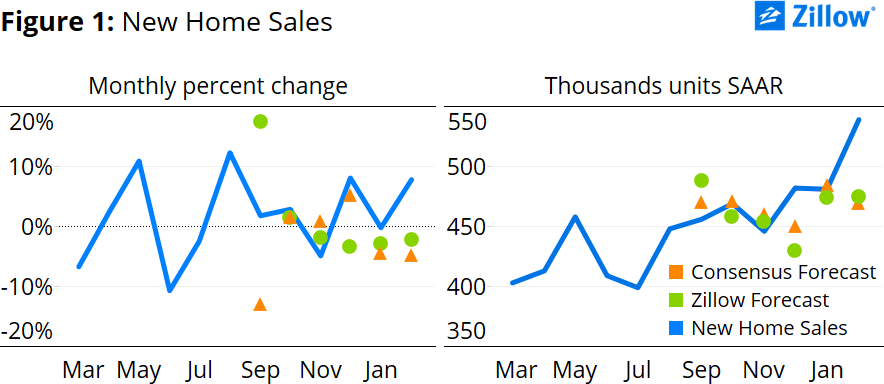- New home sales increased 7.8 percent in February to 539,000 units (SAAR), according to the U.S. Census Bureau.
- Sales unexpectedly increased in the Northeast, more than doubling despite very poor weather.
- The median price of new homes sold fell 7.7 percent year-over-year, to $272,600 (seasonally adjusted), the largest monthly decline since February 2011.
February’s new home sales data surprised everyone, rising 7.8 percent from January to 539,000 units at a seasonally adjusted annual rate (SAAR), according to the U.S. Census Bureau. The consensus forecast was a decrease of 2.5 percent from January, and Zillow expected a decrease of 1.2 percent.
Unlike existing home sales in the Northeast, new home sales did not appear to be slowed by one of the coldest Februaries on record for many major cities in the region. Sales of new homes in the Northeast were up 153 percent from January and 72 percent year-over-year. The 43,000 units (SAAR) sold in the Northeast this February was the largest monthly sales number in seven years. Sales in the South and West were also up sharply year-over-year (22 and 34 percent respectively). Compared to January, sales in the West were down 6 percent, while sales in the South were up 10 percent.
The median seasonally-adjusted price of new homes sold in February fell 8 percent from January to $272,600 from $294,100, the largest monthly decline since February 2011. Some of this decrease can be attributed to the changing composition of sales within price groups. The share of new homes sold at or just below the median sales price – between $200,000 and $299,999 – increased from 32 percent of all sales overall in 2014, to 39 percent in February. New homes sold at a price of $300,000 or more fell from 45 percent to 40 percent of all new homes sold.
This changing composition of sales away from the higher end home resulted in a lower median price. It could also represent the beginning of a shift in builder priorities away from selling less, more expensive homes to selling more, less expensive homes geared toward the kinds of younger, entry-level buyers expected to represent the biggest buying group this year.
